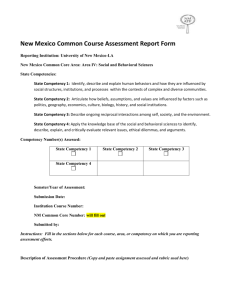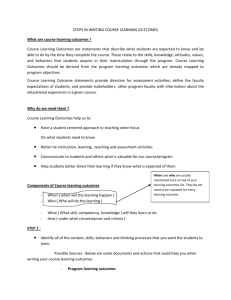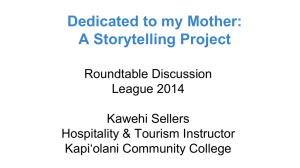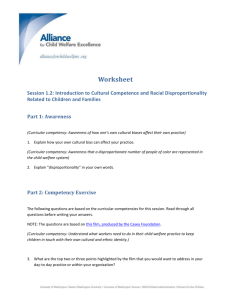Formative Assessment Development Guide
advertisement
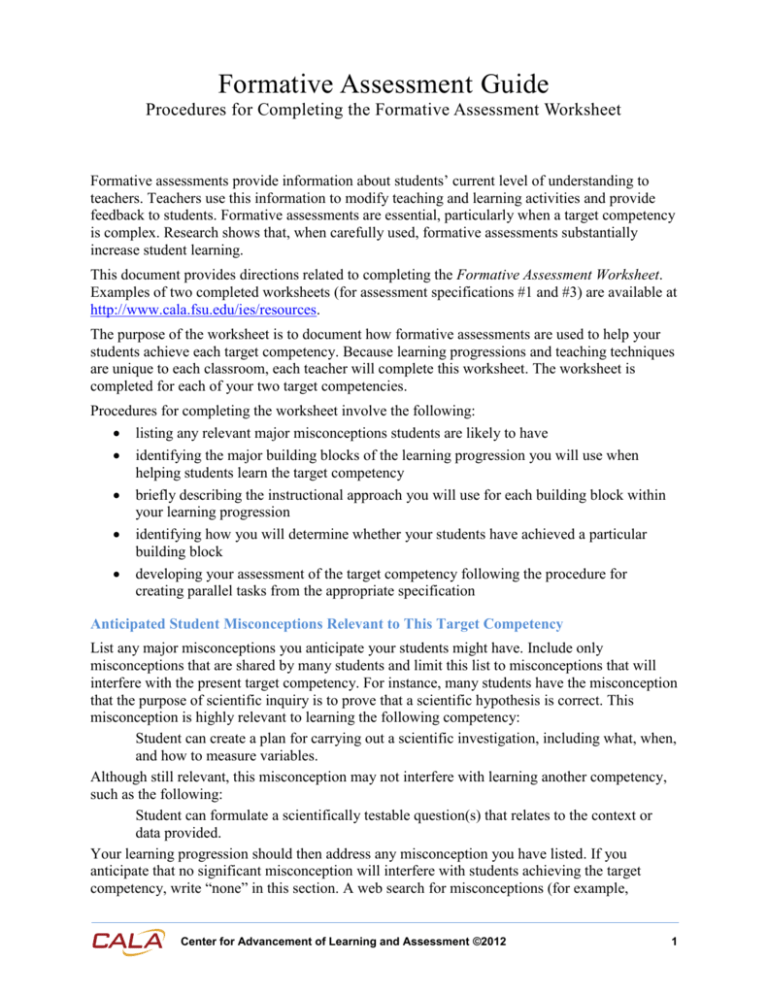
Formative Assessment Guide Procedures for Completing the Formative Assessment Worksheet Formative assessments provide information about students’ current level of understanding to teachers. Teachers use this information to modify teaching and learning activities and provide feedback to students. Formative assessments are essential, particularly when a target competency is complex. Research shows that, when carefully used, formative assessments substantially increase student learning. This document provides directions related to completing the Formative Assessment Worksheet. Examples of two completed worksheets (for assessment specifications #1 and #3) are available at http://www.cala.fsu.edu/ies/resources. The purpose of the worksheet is to document how formative assessments are used to help your students achieve each target competency. Because learning progressions and teaching techniques are unique to each classroom, each teacher will complete this worksheet. The worksheet is completed for each of your two target competencies. Procedures for completing the worksheet involve the following: listing any relevant major misconceptions students are likely to have identifying the major building blocks of the learning progression you will use when helping students learn the target competency briefly describing the instructional approach you will use for each building block within your learning progression identifying how you will determine whether your students have achieved a particular building block developing your assessment of the target competency following the procedure for creating parallel tasks from the appropriate specification Anticipated Student Misconceptions Relevant to This Target Competency List any major misconceptions you anticipate your students might have. Include only misconceptions that are shared by many students and limit this list to misconceptions that will interfere with the present target competency. For instance, many students have the misconception that the purpose of scientific inquiry is to prove that a scientific hypothesis is correct. This misconception is highly relevant to learning the following competency: Student can create a plan for carrying out a scientific investigation, including what, when, and how to measure variables. Although still relevant, this misconception may not interfere with learning another competency, such as the following: Student can formulate a scientifically testable question(s) that relates to the context or data provided. Your learning progression should then address any misconception you have listed. If you anticipate that no significant misconception will interfere with students achieving the target competency, write “none” in this section. A web search for misconceptions (for example, Center for Advancement of Learning and Assessment ©2012 1 “misconceptions about abiotic factors”) may be helpful. Also, Making Sense of Secondary Science by Rosalind Driver, et. al, includes a comprehensive account of research on student misconceptions about science. Learning Progression Leading to the Target Competency List the building blocks that make up the learning progression you will use to help your students achieve the target competency. A learning progression consists of carefully sequenced building blocks that students must achieve en route to a more complex target competency. Building blocks consist of subskills and enabling knowledge that will lead to the target competency. These building blocks are listed in reverse chronological order, indicating that each block builds on the one below it. It is important to express each building block as a measurable goal. Therefore, word each goal so that it clearly indicates what students would be observed doing when they achieve the goal. Here is a good example of a measurable goal: Student can identify questions that are scientifically testable. This measurable goal clearly suggests what a student who has achieved the goal will be observed doing, which makes it much easier to develop the assessment. It also makes planning instruction more efficient because the intended instructional outcome is clear. Contrast this to the following goal, which is inappropriately worded: Student knows what makes a question scientifically testable. This example is vague because it is unclear what knowledgeable versus less knowledgeable students do. Consequently, planning instruction and developing the assessment will be more difficult. A common mistake is to state building blocks as descriptions of classroom activity or learning strategies rather than outcomes of learning. Here is an example of this mistake: Students will be provided examples of research questions to evaluate. Again, measurable goals clearly suggest how students’ proficiency with each goal will be assessed. They also provide a better guide to planning class activities because they establish the student outcomes you are trying to achieve. The stated measurable goals serve as labels for each building block. A learning progression might include fewer than five building blocks. Should that be the case, begin listing your measurable goals in the space provided for Building Block 1, leaving blank space(s) at the top. If a learning progression includes more than five building blocks, list only the five measurable goals that you believe to be the most significant. For each building block, indicate whether declarative knowledge or procedural knowledge will be the focus. This will influence how the measurable goal is worded and definitely affect how it is assessed. When the focus is on declarative knowledge, students are assessed by asking them to Center for Advancement of Learning and Assessment ©2012 2 explain something or otherwise state what they know. When the focus is on procedural knowledge, students are assessed by having them employ the procedure, such as through demonstration of a technique or classification of previously unused instances as examples versus nonexamples of a concept. Description of Activities for Each Building Block For each building block, do the following: Copy/paste each building block from your learning progression into the box provided. For the remainder of the worksheet, building blocks are developed sequentially. Begin with Building Block 1 at the top of page 2 of the worksheet. In the space provided, describe in two to four sentences what you will do with your students to help them achieve this particular building block. Your instructional strategy for a given building block may differ from another teacher’s strategy. You alone know what works best for you and your students. (Completed worksheets accompany these directions and can be used as examples.) In the space provided, state how you will assess this building block. In other words, what will you ask your students to do to establish whether they have achieved this building block? Begin by identifying the assessment format you will use. Examples may include, but are not limited to, oral questions of the class as a whole, a task involving small groups of students, or a paper handout to each student. In each assessment, the task used should reflect the type of knowledge involved. If the focus is on declarative knowledge, the task should involve explanations or similar actions by students. If the focus is on procedural knowledge, the task should involve using the procedure, such as applying a technique or classifying previously unused instances as examples versus nonexamples of a concept. (Completed worksheets accompany these directions and can be used as examples.) Your descriptions will be most useful if you identify specific observable actions you and your students will do. See the completed worksheets that accompany these directions for examples of these descriptions. Description of Activities for Target Competency The target competency acts as the final building block of the learning progression and is handled somewhat differently. Space is provided for you to describe the classroom activities you will use to help students move from the prior building block to this target competency. Your students are to be formatively assessed (and later summatively assessed) on this target competency using tasks you devise based on the assessment specification you have been provided. The second portion of the Formative Assessment Worksheet serves as a template for developing your formative assessment of the target competency. The specification also describes the criteria for scoring students’ performance. In your description of classroom activities, describe how you would share with your students the scoring criteria that will be used to assess their proficiency with the target competency. Center for Advancement of Learning and Assessment ©2012 3




